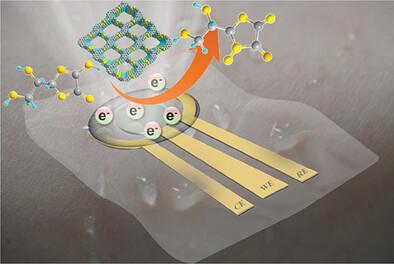Hydrogen-Bonded Organic Framework Films Integrated with Wavy Structured Design for Wearable Bioelectronics
IF 13
2区 材料科学
Q1 CHEMISTRY, MULTIDISCIPLINARY
引用次数: 0
Abstract
The integration of hydrogen-bonded organic frameworks (HOFs) with flexible electronic technologies offers a promising strategy for monitoring detailed health information, owing to their inherent porosity, excellent biocompatibility, and tunable catalytic capabilities. However, their application in wearable and real-time health monitoring remains largely unexplored, primarily due to the mechanical mismatch between the traditionally fragile HOFs particles and the softness of human skin. Herein, this study demonstrates an epidermal biosensor that maintains reliable sensing capability even under extreme deformation and complex environmental conditions by integrating HOFs films with wavy bioelectrodes. This wearable biosensor demonstrates ultrasensitive detection capabilities, with a limit of detection of 49.64 nM, and accurately measures nutritional content in sweat while conforming to curved skin surfaces. The sensor's performance is comparable to those obtained using high-performance liquid chromatography (HPLC). More strikingly, scratched HOFs films can be regenerated through a simple solvent rinsing process, enabling their reuse in the fabrication of new biosensors and offering a significant advantage over conventional sensing materials. This work has the potential to inspire the development of more flexible electronic devices, leveraging the structural adaptability and diversity of HOFs for personalized healthcare applications and real-time health monitoring.

氢键有机框架薄膜与波浪形结构设计相结合,用于可穿戴生物电子学
氢键有机框架(HOFs)具有固有的多孔性、良好的生物相容性和可调的催化能力,因此,将氢键有机框架与柔性电子技术相结合为监测详细的健康信息提供了一种前景广阔的策略。然而,它们在可穿戴和实时健康监测方面的应用在很大程度上仍未得到探索,这主要是由于传统上脆弱的 HOFs 颗粒与人体皮肤的柔软性之间存在机械不匹配。在此,本研究展示了一种表皮生物传感器,通过将 HOFs 薄膜与波浪形生物电极相结合,即使在极端变形和复杂的环境条件下也能保持可靠的传感能力。这种可穿戴的生物传感器具有超灵敏的检测能力,检测限为 49.64 nM,能准确测量汗液中的营养成分,同时还能贴合弯曲的皮肤表面。该传感器的性能可与使用高效液相色谱法(HPLC)获得的结果相媲美。更引人注目的是,划伤的 HOFs 薄膜可以通过简单的溶剂漂洗过程再生,从而可以在制造新的生物传感器时重复使用,与传统传感材料相比具有显著优势。这项工作有望启发人们开发更灵活的电子设备,利用 HOFs 的结构适应性和多样性实现个性化医疗保健应用和实时健康监测。
本文章由计算机程序翻译,如有差异,请以英文原文为准。
求助全文
约1分钟内获得全文
求助全文
来源期刊

Small
工程技术-材料科学:综合
CiteScore
17.70
自引率
3.80%
发文量
1830
审稿时长
2.1 months
期刊介绍:
Small serves as an exceptional platform for both experimental and theoretical studies in fundamental and applied interdisciplinary research at the nano- and microscale. The journal offers a compelling mix of peer-reviewed Research Articles, Reviews, Perspectives, and Comments.
With a remarkable 2022 Journal Impact Factor of 13.3 (Journal Citation Reports from Clarivate Analytics, 2023), Small remains among the top multidisciplinary journals, covering a wide range of topics at the interface of materials science, chemistry, physics, engineering, medicine, and biology.
Small's readership includes biochemists, biologists, biomedical scientists, chemists, engineers, information technologists, materials scientists, physicists, and theoreticians alike.
 求助内容:
求助内容: 应助结果提醒方式:
应助结果提醒方式:


